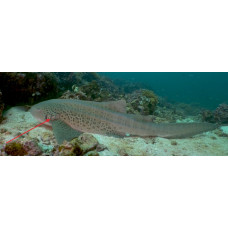Gill opening (slit)-formed by the gill cover and the body surface, serves to release water from the gill cavity to the outside during breathing.
Openings communicating the intestinal cavity with the external environment (directly or through special cavities) and serving, due to the presence of vessels on their edges, for blood oxidation.
The gill slits may lead not directly into the intestine, but into the gill sacs, and these latter already open into the intestine, and then the external and internal slits are distinguished.
Such a phenomenon, representing a more primary relationship, is observed in intestinal gills, in round-mouthed fish and selachia.
In another case, due to the reduction of the sacs, the gill slits are reduced to simple openings separated from each other by relatively narrow piers (gill arches), as is the case with tunicates, craneless, and also, although in a different form, ganoids and bony fish.
In intestinal gills, the slits are numerous and open on the dorsal side in two rows directly outward. The cephalodisk has one pair. The number of slits is also different in the shells: the tailed ones (Copelatae) have one pair, and it opens directly outwards. In other tunicates, the slits open into a special surrounding gill section of the intestine or a cavity adjacent to it (peribrachial, or cloacal), and it already opens outwards. In ascidia, they are very numerous and are divided by crossbars into smaller holes, so that the entire anterior part of the intestine is a perforated mass of holes. In Doliolum, the gill cavity communicates with the cloacal one by two few rows of slits, and in salpas these two rows are replaced by two huge holes, so that the partition between the gill and cloacal cavity is reduced to the degree of a narrow median crossbar that plays the role of a gill. In the craneless in the embryonic state, the slits open directly outward, but in the adult lanceolate — into the peribrachial cavity and reach up to 180 pairs. Each slot is divided by crossbars.
In vertebrates, the gill slits are in various numbers. The largest number are Myxinidae of the roundworms, namely, in various species of Bdellostoma, this number reaches 10, 12 and even 14 pairs.
There is reason to think that 14 pairs is the starting number for lower vertebrates. Then, Myxine and Petromyzon have 7 gill slits, but in Myxine the outer slits connect into one on each side, and in Petromyzon the inner ones do not open directly into the intestine, but into the channel lying under it and opening into the intestine with the anterior end and representing the anterior part of the larval intestine. In the selachia, the number of external and internal slits is the same and usually 6 pairs, but the front of them opens especially, does not serve for breathing and is called a bryzgalets (spiraculum), so that the gill slits are 5 pairs, and together with the bryzgalets they are called visceral.
However, in Heptanchus and Chlamidoselache sharks, this number increases to 6, and in Hexanchus — to 7, and with a sprinkler, the last digit will be 8. In the round-mouthed, the rudiment of another (8th) pair in the form of two shimmering grooves is also found in front of the first gill slit, so for the next phylogenetic stage of vertebrates, the number of 8 pairs should be taken as typical.
In some ganoids, the splatter is still preserved, but in bony fish it completely disappears, and the number of gill slits in fish is usually 5 pairs, and sometimes less. Amphibians have 5 pairs of gill sacs, but the first pair (splashy) does not break through, and the number of gill slits in adult tailed generally decreases (from 4 to 2), and in tailless they disappear altogether.
In tailless amphibians and Amniota, the gill slits are provisor (5 pairs in amphibians and reptiles), and the splashy pair is represented by the middle ear. Already in Chlamidoselache there is a fold in front of the first pair of gill slits (behind the splashes), which covers the gill slit and on the abdominal side fuses with the fold of the other side, forming a collar characteristic of this shark. This fold is the first rudiment of the gill cap (operculum), covering the gill slits in other fish and some amphibians. Usually water enters the mouth and exits through the gill slits, but in lampreys, when they suck, water enters and exits through the gill slits. On the gill arches or on the inner surface of the gill sacs in vertebrates, gill petals sit, which are the site of blood oxidation.
Gill slit
Tags: gill slit

